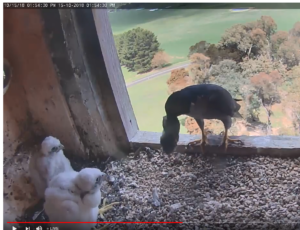Our youngsters, Gaama and Budhin (no, I can’t tell them apart at this stage, perhaps in a week?), 19-20 days old, have finally started moving out of their corner, even without the food to lure them. Here they take tentative steps towards the ledge (but not too close…..). Actually, shortly, afterwards, lunch arrives, so perhaps they DID know food was coming. I’ve noticed peregrines have an uncanny ability to sense the arrival of dinner well before we can!
VIDEO 20181015 1352 Gaama and Budhin survey their world
We have noticed that, although Diamond has frequently rejected Xavier’s offerings of starling (and I don’t I’ve ever seen her bring one in that she’s hunted herself), she will feed them to the young if they are hungry. But she will take quite small birds such as small honeyeaters, and, even a couple of times, she has taken pardalotes (very beautiful, but tiny birds of the outer foliage), so it’s not size that’s putting her off. I believe they are quite tough (and probably dirty as they are often seen at the tip). What’s odd is that I haven’t seen any juvenile starlings yet – usually a staple at this time of year. Plentiful, stupid, less tough and defenceless (and, of course, a pest in Australia). They are adult sized, just about, but a medium to dark brown, rather than shiny black.
Cilla

Hey Cilla, just the other day, Xavier was feeding the youngsters a nice rosella when Diamond arrived with a fresh starling (I know – amazing! She’d evidently been slumming it…) The expression on her face was priceless! She dumped the starling in the middle of the box, grabbed the rosella from Xavier and shooed him out, then carried on feeding the kids their delicious rosella.
I didn’t know that starlings are a pest in Australia.
I really like them here in Holland, a smart bird with various vocals.
I couldn’t be happier that they are finally venturing out of their corner. So nice to be able to see them and all the progress. Amazing how much they’ve changed while hiding from the cam. Thank you Cilla
Starlings are a major pest, particularly in agricultural areas. They are in huge numbers and do a lot of damage to crops, vines etc. They also seem to ‘take over’ reed beds and outcompete the locals.